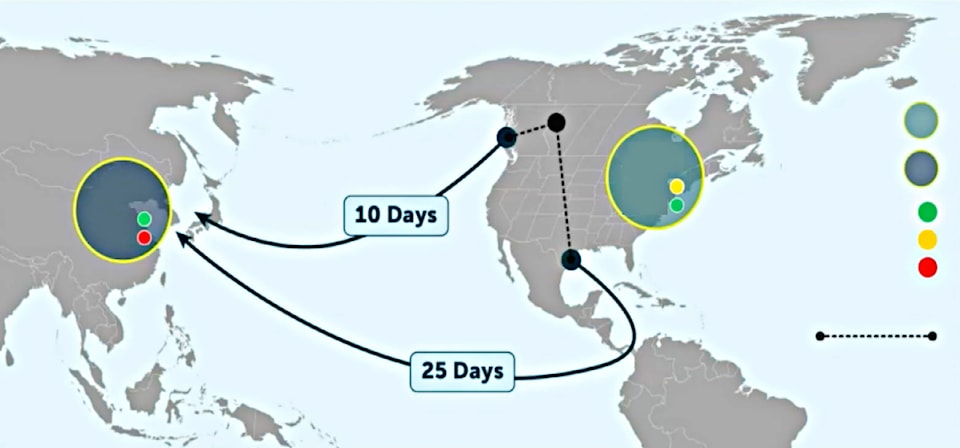The company that intends building a propane processing facility along the Bish Cove road says it will roll out a rigorous program of community engagement this year.
Pacific Traverse Energy (PTE) spokesperson Jon Turner said last week the company plans to deliver an accessible engagement program “that provides a meaningful opportunity to incorporate community input into the project.”
Pacific Traverse Energy’s goal is to obtain the necessary approvals, construct and operate a propane export facility in Kitimat, with the support of the community,” said Turner.
“We will begin our public community engagement with First Nations, stakeholders and community members in the spring of 2019.”
Turner said PTE is also planning to host project information sessions, also beginning this spring.
“Our focus over the next year is to expand our engagement and begin our community relations program, initiate permitting and undertake the engineering studies that will allow us to make important project decisions in 2020,” said Turner.
“We plan to begin construction in 2020 so we are ready to ship propane to our Asian customers in late 2022 or early 2023.”
He said the company has already met with key stakeholders “to introduce the proposed project and develop relationships,” including a meeting in January with the Kitimat Rod and Gun Club.
He said through early discussions with key stakeholders the company had received feedback about a number of issues, including the importance of collaboration with the community, the sighting of the railyard, public safety with respect to the facility, rail and marine transport, and local and regional employment and training opportunities.
Turner said PTE will be opening a community office in Kitimat that will be staffed by a company representative.
“The community office will provide a location for PTE to meet with community groups, be available to the public and provide a base for our Kitimat operations,” said Turner.
The project will be completed in three stages– the first a railyard which will be used to park special railcars carrying propane from northeastern B.C. and Alberta on CN tracks to the rail terminus in Kitimat for offloading.
The second stage will see the construction of a nearly 15km-long small diameter pipeline to transport the propane through the Service Centre, past Rio Tinto’s plant to the third stage, a facility where the propane will be super-cooled, pumped to a floating storage vessel and transferred to as many as three tankers a month destined for clients in Asia.
The need for community engagement was underscored at a council meeting on January 21, when Turner and PTE executive vice president for project delivery, Jason Tielker, presented a project update.
Also present at the meeting was Douglas Channel Watch’s Elizabeth Thorne, and Cheryl Brown who appeared in her personal capacity.
Thorne directly addressed PTE’s project, raising a number of concerns and emphasizing the need for community engagement.
She said that LNG Canada’s proposed salt marshes in Minette Bay had received government approval despite the fact that LNG Canada had not consulted groups like Douglas Channel Watch and Kitimat Valley Naturalists.
“Industry has to co-operate for the good of the community if they want to be part of the community,” said Thorne in her presentation which related to rail safety associated with the PTE project.
She expressed concern about the proposed railyard to the north of Kitimat, noting that it is located near to Goose Creek, which she said is a prolific salmon spawning stream, as well as an important habitat for wildlife, including grizzly and moose.
“Is it possible for PTE to work with Kitimat LNG to find a way to use their railyard,” asked Thorne.
She said the Goose Creek site and the other two sites that were considered “have serious environmental issues,” while the old Eurocan site has none.
“The days of industry operating on the basis of hanging onto what’s theirs for no other reasons other than that it’s theirs are gone.”
Thorne also pointed to another two issues that needed addressing – the lack of a provincial environmental assessment and a risk management and safety strategy.
She asked council to consider a number of actions, including communicating its emergency response plans to the public and allow for public involvement, voicing council’s concerns to the B.C. government about the non-existence of an environmental assessment which she said should include risks associated with increased rail traffic of dangerous goods to the community, potential threats to wetlands and fish-bearing streams, emergency preparedness and climate change impacts.
In his presentation, Turner said bringing rail to the proposed site of the propane facility is not feasible and that the brownfield sites they had looked at didn’t provide the right opportunity.
PTE is conducting geotechnical work on the proposed site for the railyard, located three kilometres from the northern end of the Service Centre.
The geotechnical work, which is being conducted on Crown land, falls under the purview of a two-year exploratory licence issued by the provincial government in 2018.
Turner said the company has also been issued a 25-year propane export licence from the National Energy Board to ship as much as 16 million barrels of propane a year to Asian customers.
Based on its projected export volume, propane from as many as 60 railcars a day would be emptied at the company’s planned railyard and the railyard would hold between 200 to 300 cars. - with files from Rod Link
